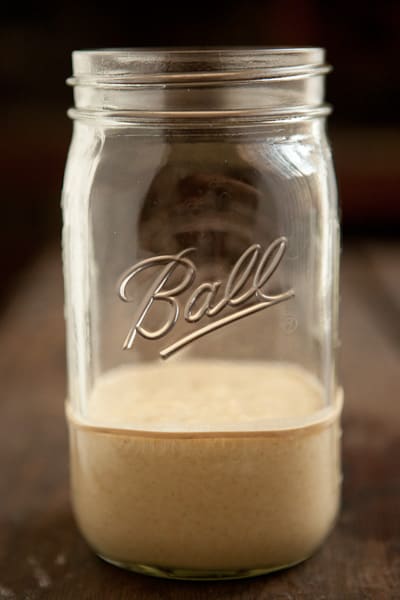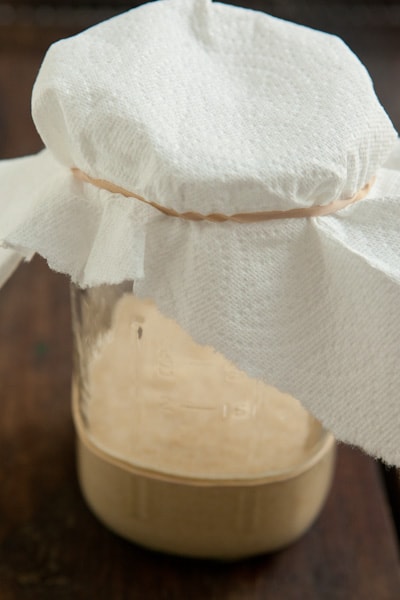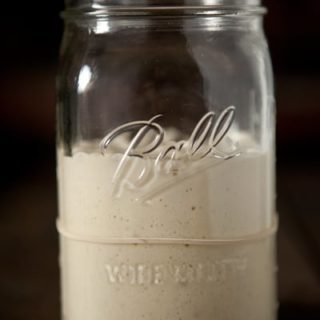
Today we begin the great sourdough starter experiment. The goal of this experiment is to catch some wild yeast and try to keep them happy so that they will multiply. By harnessing the power of wild yeast in a sourdough starter, we’ll eventually be able to bake bread without using any commercial yeast at all.
Let’s get started!
There are several different ways to create a sourdough starter and I don’t know that any one method is truly better than the others. I’m using Peter Reinhart’s method from The Bread Baker’s Apprentice, but what I’m about to share with you is a bit different than what’s in the book. That’s because he updated the method after the book was published and shared the correction on his blog.
So, I’m using Mr. Reinhart’s updated instructions with a few small changes of my own. I have successfully created a sourdough starter before, but haven’t used this exact method, so we really are embarking on a brand new adventure together. (Update: this method works great! Scroll to the very bottom of the page for printable instructions.)
Here’s how I started: I mixed one cup of whole wheat flour with 3/4 cup of room-temperature pineapple juice in a bowl until everything was well blended. I scraped the mixture into a clean glass jar and marked the level with a rubber band so that it will be easy to detect any growth if it occurs. I covered the jar with a paper towel and secured it with a rubber band. Now all I have to do is let the jar sit at room temperature for 24 hours. Pretty easy so far, right?

How to Create a Sourdough Starter
It takes about a week to create a sourdough starter that is strong enough to bake bread, but you will only spend a few minutes a day of active time.
If you click on the links in the instructions below, you will see step-by-step photos and descriptions of my own process of making a sourdough starter from scratch. For a printable recipe of how to make a sourdough starter, scroll to the very end of this post.
Day One: In a small bowl, mix one cup of whole wheat or whole rye flour with 3/4 cup (6 oz) canned pineapple juice (at room temperature) until all of the flour is hydrated. Scrape mixture into a quart-size wide mouth glass container, such as a jar or glass measuring cup. Mark the level of the starter with a piece of tape or rubber band. Cover the container with a paper towel, cheesecloth, or coffee filter and secure with a rubber band. Leave at room temperature for 24 hours.
Day Two: You probably won’t notice much change at this point. Scrape the contents of the jar into a mixing bowl and add 1 cup of unbleached all-purpose plus 1/2 cup pineapple juice (make sure juice is room temperature). Mix until all ingredients are evenly distributed. Wash and dry your glass container and scrape the mixture into the container. Mark and cover the container just like day one. Let sit at room temperature for 24 hours.
Day Three: You may notice some activity at this point. The mixture may have risen some and there might be bubbles. Regardless of whether you notice any fermentation or not, discard half of the mixture (or give it to a friend to cultivate), and mix the remaining half with 1 cup of unbleached all-purpose and 1/2 cup filtered water (make sure water is room temperature). Wash and dry your container and scrape the mixture into the container. Mark and cover as before. Let sit at room temperature for 24 hours.
Day Four: The mixture should have at least doubled in size at this point. If it seems to be sluggish and hasn’t doubled in size, allow it to sit at room temperature for another 12 to 24 hours. Otherwise, repeat instructions for Day three.
Day Five: Feed the starter (repeating day three instructions) first thing in the morning and then again in the evening (about 12 hours apart).
Day Six: If your starter has been very active and always doubles in size (or more) between feedings, then your starter is ready to bake with. You may also choose to refrigerate your starter at this point and slow down the feedings to once a week. If you’d like to bake some bread, here is a basic sourdough bread recipe to get you started. If your starter still seems a little sluggish, continue with the twice daily feedings as above.
Day Seven: Same as above.

How to Make a Sourdough Starter
Ingredients
- 5-pound bag unbleached all-purpose flour
- 1 cup whole wheat flour or whole rye flour
- 1 1/4 cups pineapple juice
- filtered or bottled water*
Instructions
- Day One: In a small bowl, mix one cup of whole wheat or whole rye flour with 3/4 cup (6 oz) canned pineapple juice (at room temperature) until all of the flour is hydrated. Scrape mixture into a quart-size wide mouth glass container, such as a jar or glass measuring cup. Mark the level of the starter with a piece of tape or rubber band. Cover the container with a paper towel, cheesecloth, or coffee filter and secure with a rubber band. Leave at room temperature for 24 hours.
- Day Two: You probably won't notice much change at this point. Scrape the contents of the jar into a mixing bowl and add 1 cup of unbleached all-purpose or unbleached bread flour plus 1/2 cup pineapple juice (make sure juice is room temperature). Mix until all ingredients are evenly distributed. Wash and dry your glass container and scrape the mixture into the container. Mark and cover the container just like day one. Let sit at room temperature for 24 hours.
- Day Three: You may notice some activity at this point. The mixture may have risen some and there might be bubbles. Regardless of whether you notice any fermentation or not, discard half of the mixture (or give it to a friend to cultivate), and mix the remaining half with 1 cup of unbleached all-purpose or bread flour and 1/2 cup filtered water (make sure water is room temperature). Wash and dry your container and scrape the mixture into the container. Mark and cover as before. Let sit at room temperature for 24 hours.
- Day Four: The mixture should have at least doubled in size at this point. If it seems to be sluggish and hasn't doubled in size, allow it to sit at room temperature for another 12 to 24 hours. Otherwise, repeat instructions for Day three.
- Day Five: Feed the starter (repeating day three instructions) first thing in the morning and then again in the evening (about 12 hours apart).
- Day Six: If your starter has been very active and always doubles in size (or more) between feedings, then your starter is ready to bake with. You may also choose to refrigerate your starter at this point and slow down the feedings to once a week. If you'd like to bake some bread, here is a basic sourdough bread recipe to get you started. If your starter still seems a little sluggish, continue with the twice daily feedings as above.
- Day Seven: Same as above.
Notes
*The reason I suggest filtered or bottled water is that chlorinated water straight from the tap might make it more difficult for your starter to get going. Some people have had no trouble using filtered water, but if you're going to invest the time in creating a sourdough starter from scratch, why take any chances? I filter my tap water through a Brita water pitcher. Any cheap bottled water would be fine, too. The only thing we're trying to avoid is chlorine. If you know that your tap water is not chlorinated, feel free to use it without filtering it.
Tina says
Fred Wilson says
Cindy says
Nicole says
Andrea Binder says
Rachel says
Feroza Saeed says
Nicole says
Nicole says
LostInTheWoods says
Greg Pope says
Nicole says